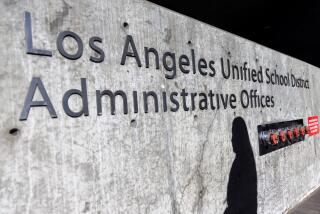BUENA PARK : Grades 6 to 8 to Begin AIDS Education
- Share via
Amelia I. Juarez knows the seriousness of AIDS. Her brother died of the disease.
“The death (from AIDS) is the most terrible thing I’ve seen,” said Juarez, a parent and teacher’s aide in the Buena Park School District.
“A lot of people are so naive they don’t realize how serious this is. We have to get to our young ones and educate them,” she said, in tears. “They don’t understand . . . that there is no cure for it.”
But the district students in sixth, seventh and eighth grades will be learning about AIDS--how it is transmitted and how they can avoid becoming HIV positive.
Teachers were given a lesson Friday on the disease, and the AIDS curriculum will be introduced in eighth-grade classes beginning in December.
About 250 teachers, administrators and staff members attended a morning meeting and were given a preview of the curriculum, as well as learning about confidentiality issues and laws, and how to protect themselves at school by using gloves when administering first aid involving blood.
“We wanted everyone to have the same basic knowledge so that they themselves know about AIDS,” said Sandra Barry, assistant superintendent of curriculum and instruction.
“With the rapid spread of the disease, we all will encounter someone who has AIDS--whether it’s in the classroom, among a circle of friends or a colleague.
“We think everyone needs to be prepared to answer the questions from youngsters and parents.”
The district plans to present the AIDS program, approved by trustees in July, to seventh-graders in January, with sixth-graders introduced to the curriculum in March. Parents will be notified when the program begins and must give permission for their children to receive AIDS instruction.
Shirley Carey, a nursing consultant who specializes in community health education, presented a lecture to district personnel and told the group that they can make a difference.
“This is a totally preventable disease and it’s criminal the way it’s spreading,” Carey said. “The more we can get the factual information out, the more we can stop the disease.”
Carey told school officials that while the occupational risks for teachers are very low, they need to take precautions.
“You need to assume that kids are potentially infected and treat everybody the same way to reduce the risk of exposure,” she said.
Teacher Susan McClelland, who will incorporate the AIDS curriculum as part of the life science program for seventh-graders, said educating herself about AIDS helps make it more comfortable to teach in the classroom.
“You have to be prepared,” she said.
More to Read
Sign up for Essential California
The most important California stories and recommendations in your inbox every morning.
You may occasionally receive promotional content from the Los Angeles Times.









